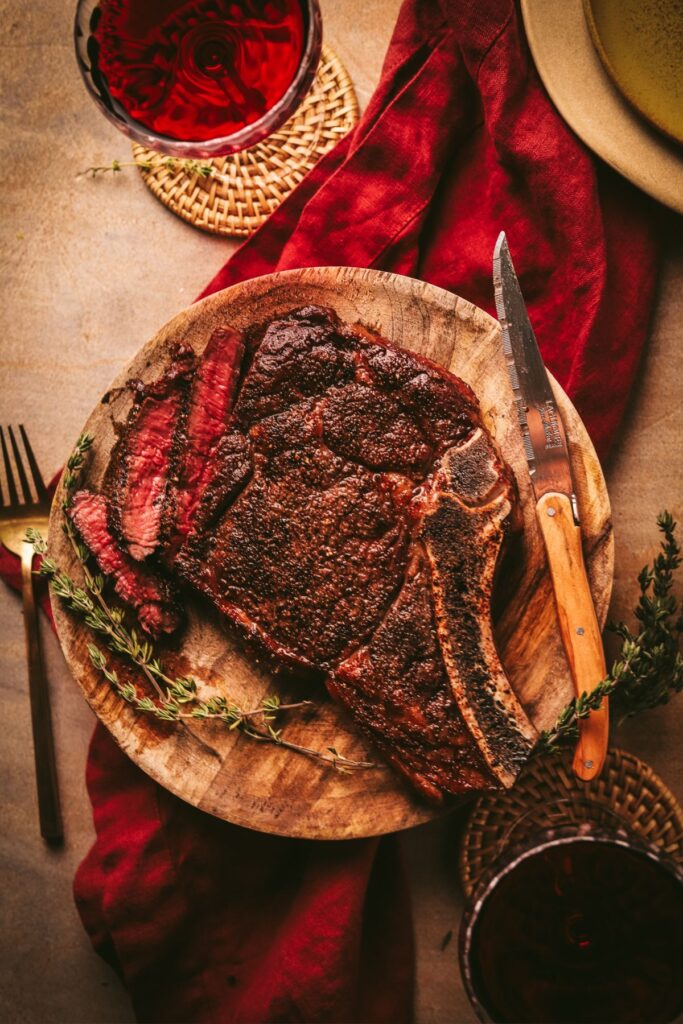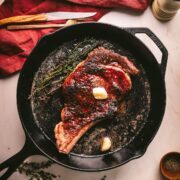As an Amazon Associate I earn from qualifying purchases.
Nailing the perfect internal steak temperature (or, your preferred doneness on a steak) can feel like a futile exercise. But I'm here to tell you, it doesn't have to be. After years and years of testing and experimentation, I'm hear to tell you all my best tips and tricks on getting your steak to the perfect temperature at home, every time. And the good news is, you don't have to be a Michelin-star chef to make it happen.

Perfecting the internal temperature of steak is both an art and a science. But, luckily for us, in the last few years it's become more of a science, with plenty of tools to help us along the way (i.e. we don't have to rely on the 'hand-poke' technique. IYKYK).
Jump to:
Why Does the Internal Temperature Even Matter?
The internal temperature of a steak is actually one of the most important elements for you to be able to enjoy your steak to it's full potential. Depending on the different cuts of steak, they have a different flavor and texture. The internal temperature can influence both of those things.
All cuts of steak though, from filet mignon to ribeye to striploin to tomahawk, have the potential to become chewy and tough if you over-cook them. That's why this internal temp thing is so important.
There are generally 6 levels of doneness for a steak (this is what a server will ask you about if you order one at a restaurant):
- Well-done (160°F and up): This steak is cooked completely, all the way through. You won't see any pink on the inside as you cut into it. It can definitely lean towards being tough, dry, and chewy.
- Medium-Well (145°F-155°F): This will have a slight band of pink in the center, still lean towards being a firm and dry texture.
- Medium (135°F-145°F): A medium cooked steak will have a pink center, it will still be warm/hot in the center, juicy and slightly more tender than medium-well.
- Medium-Rare (130°F-145°F): The holy grail for most when it comes to internal steak temperatures. Most steakhouses and chefs will recommend you get your steak medium-rare to optimize the incredible tender texture and juiciness of the cut. It will be a pinkish-red in the center, but still warm.
- Rare (120°F-130°F): A rare steak will have a bright red center, a super soft and juicy texture, and the center may be slightly cool to the tough when you slice it.
Pro Tip: Download or screen shot the chart below and keep it handy next time you're cooking steak!

Everyone has their own preference for how they like their steak done. I've known people who love it well done, and will never deviate from this (it blows my mind, but to each their own). See the visual chart below for what your steak should look like when it's done.
Is it Safe to Eat Rare Steak?
While the USDA says that beef should be cooked to a minimum temperature of 145°F - it's generally still considered safe to eat a rare steak. That's because the bacteria found on steak is found on the surface, which you'll be cooking off. The meat is dense, so many parasites aren't able to make their way past the surface.
In fact, there are many cultures around the world that eat steak completely raw. Anyone who's had steak tartare will tell you that this is an amazingly delightful experience, and there are tons of restaurants who don't have any issue with safety. In these cases, it's usually because the meat is coming from well-known butchers, and is extremely fresh.

Different Temperatures & Doneness Levels: Visual Guide
Steak Temperature Chart
Rather than trying to figure out how thick, how cold, or how long you need to cook your steak for, I've found that taking the steak off the heat a few degrees sooner than you want the final temperature is the KEY to cooking the perfect steak. I'm not sure why more websites don't talk about this - but this chart sums it up perfectly. And, there are some real life examples below so you can see what a cross-section should look like.
| Doneness Level | Remove from Heat at (°F / °C) | Final Internal Temperature (°F / °C) |
|---|---|---|
| Rare | 115-120°F (46-49°C) | 120-130°F (49-54°C) |
| Medium Rare | 125-130°F (52-54°C) | 130-135°F (54-57°C) |
| Medium | 130-140°F (54-60°C) | 135-145°F (57-63°C) |
| Medium Well | 140-150°F (60-65°C) | 145-155°F (63-68°C) |
| Well Done | 155-160°F (68-71°C) | 160°F and above (71°C and above) |

Nailing the Perfect Steak
So how exactly to restaurants manage factors like timing, temperature, plus the size of the cut, and come out with consistently great steak every time? There's a few ways to make sure this happens - and you can do all of them at home. Here are my best tips and tricks for cooking the perfect steak:
Use a meat thermometer. These tools are inexpensive, and absolutely essential when you're trying to get the right cook on a steak. In my mind, it's the only surefire way to cook a perfect steak, and get the timing right! You should be checking the temperature as you cook it, no matter what method you're using. The only way you can get around this is if you try a sous vide method of cooking (because it's literally impossible to overcook your steak this way).
Use a thicker cut. Thinner steaks cook super quickly, and as a result, it can be hard to control the temperature, resulting in an overdone steak in a matter of minutes. Go for steaks that are about 1.5-2" thick. This width will allow you some breathing room to make sure it doesn't over cook, and at the same time, ensure the center gets to the temperature you need it to be.
Bring your steak to room temperature. Before you start cooking the steak, you should bring it to room temperature. This stabilizes your start temperature, allowing for more control during cooking, and will make your life a lot easier. It depends on the steak, but in general, let it sit on the count for 1-2 hours before cooking (and never try and cook a steak from frozen).
Don't depend on timing. I've seen so many recipes say "cook the steak for 4-5 minutes per side". While this can be a help guide for cooking steak, it's incredibly tough to know how long a steak is going to take - especially given the difference in size. Use your meat thermometer for accurate results! Check it multiple times if you have to. Most of my steak recipes have charts for timing depending on the cut and the thickness of the steak, but again, these are still just a guide.
Take it out a few degrees below where you want the final temperature to be. One of the trickiest things I find about cooking steaks to a perfect temperature is the fact that they need to rest once they've finished cooking. The problem here is that the steaks continue cooking once they're out of the pan. The way I've learned to combat this is to take them off the heat about about 5-10 degrees lower than you want the final temperature to be. This way, the steak won't overcook as it's sitting on the cutting board. See the chart above for more details, or to download it to your phone!

Different Cooking Methods
Not all cooking methods are created equal when it come to cooking steaks to the perfect internal temperature. I've tried pretty much all of them (including over an open fire. Delicious, but tricky).
Best: Reverse sear or sous vide
Both of these methods allow for precision and control over the temperature of the steak, and overall, I've gotten the best consistent results with these methods, hands down.
Reverse Sear Method: Slowly cooking the steak at a low temperature first allows for even cooking throughout, ensuring the desired internal temperature is reached without overcooking the outer layers.
Sous Vide Method: By vacuum-sealing the steak and cooking it in a water bath at a precise temperature, you have complete control over the internal temperature, resulting in consistent and perfect doneness every time.
Good: Grilling or Stove-Top Searing
Both of these methods are good, but leave more room for error. If you keep your meat thermometer handy though, you should be good to go. Just don't wander away during the cooking process.
Grilling: Provides intense direct heat, quickly searing the exterior of the steak while leaving the inside juicy. However, achieving precise internal temperatures can be challenging.
Stove-top Searing: Allows for high-heat searing, creating a flavorful crust on the steak. However, without careful monitoring, it's easy to overcook the steak, resulting in uneven doneness.
Advanced: Over an open flame
While the flavor here is pretty unbelievable, it's just so hard to do. You have almost zero temperature control, making it almost impossible to know what's going on, unless you've packed your thermometer. Still a fun challenge though - highly encouraged!
Amazing Steak Recipes to Try
Now that you know exactly how you're going to perfect the internal temperature of the steak, here are a few awesome recipes to experiment with!
Hi, I'm Cara! I'm a food writer, journalist, and recipe developer. I'm obsessed good food, good wine, good cocktails and entertaining. I've picked up a few tips over the years, and love sharing them with others.












Leave a Reply